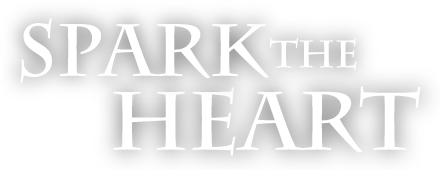Leaning In, Grounding Down, Remembering Fun
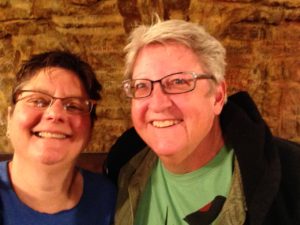
After our immersion of 11 days, 3 times a day treatments in the radon mine, we were both excited to have some free time to get out and start exploring the area.
On Thursday morning we went to the tiny Farmer’s Market in the next town. On the way, I said, “I think I’m finally going to find my silver earrings today. And for a reasonable price.”
And I DID. A retired man named Bob makes chain-maille earrings, different designs, different colors. Only $12. And if I lose one, I can send him the remainder and he’ll make a new one for $6. WOW!
We also got delicious snow peas from the youth garden, and beets, apricots, baby carrots, zucchini, a bag of purple, yellow and white cauliflower, and a quart of relish pickles, all from nearby Conrad, MT.
We had fun going up and down every aisle in the hometown hardware store, past crock pots and BBQ grills, fishing lures and poles, glue sticks, rubber gloves, knives, bullets, and contact paper that looked like wood. There were also the expected paint cans and color samples, an aisle for plumbing and electrical, and, in the backroom, old metal drawers neatly hand labeled for every size spring, screw, nut and bolt. And, in the showroom through the last door, there were washers and dryers, a refrigerator, and several models of wood stoves. I looked for a new hooking key chain. The man behind the counter showed me three kinds, but they were all too bulky, so we just bought a pair of earplugs for 49¢.
Outside, we took pictures of the old murals on the sides of the brick building, and checked out the six-lane bowling alley/bar/casino. Tim, the owner, was in his office counting dollar bills while he answered my questions. Bowling is from noon to 2 am, every day. $2.75 a game and 75¢ for shoes. We thought we’d invite our new friends Barry and Madge, from the campground, to play.
We stopped in the Boulder Historical Society and talked with the volunteers who were compiling marriage and death dates from old newspapers. And then suddenly, I had to go outside and sit on a bench. I was exhausted.
We skipped lunch at the Local Supper Club Restaurant and headed home. I ate some turkey and some of the pickles, in case it was just low blood sugar. Marika checked my oxygen level-97%, and my blood pressure-117/70. Everything was normal, so I got into bed. I slept for three hours, got up, peed, had a pretzel and went to sleep again until 7.
I watched Chelsea Clinton introduce her mother, listened to Hillary’s speech, and went to bed after 10. I didn’t get up again until 10 in the morning.
I realized I had what they call the mine sickness. It’s the body processing all of the radon gas. And I just needed to rest, drink lots of water, and ride it out.
I ate a bowl of cereal, talked with Marika, checked my email, and went back to sleep for another 3 hours. In the evening I put on some clothes and went for a short walk, but I had to lie down when I got back.
As I laid in bed, too tired to do anything between sleeping, I remembered that when I’ve gone to retreats, another kind of immersion, each time, I’ve come home exhausted. Once I realized this, I leaned all the way in, grateful that we had nothing on the calendar for the rest of the week. I allowed myself to sleep, watch TV, and eat whatever sounded good. And I walked a little, to keep my body from getting sore and stiff.
And, in this down time, I opened up my copy of Heart Sparks to the first practice, realizing that Grounding is exactly what this is, and exactly what I need.
After this amazing experience, and really, ALL of the changes since we decided to live this new life on the road, nothing is the same. And so now is a time to begin again, to ground myself and explore what ELSE I want to live into.
I am re-committing to a daily stretching practice. And brisk walking. And deep breathing. I’m hardly coughing, but my lungs still feel tight and I get winded after exertion. But we are at 5600’. I’m curious to see how things will be once we are on the coast, at sea level. I also feel looser in my hips and joints. Marika hasn’t admitted to any improvements yet, but it can take a few weeks for benefits to appear.
I felt 100% by Sunday and we had a blast bowling with Barry and Madge. The gals bowled and Barry kept score. It was so much fun, even if my muscles were screaming sore the next day. It reminded me that I like doing something over and over again to hone the skill and get better. And that I can trust my body to be more physical and active. And how much I like to have fun!
The Power of Immersion
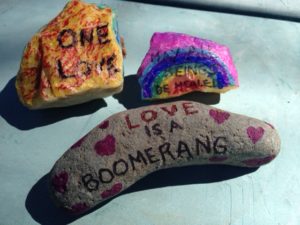
As you read this, we are on our last day of the 11 day radon mine treatment. It has been an amazing experience to fully commit to doing this 3 times a day for the last 11 days. Our days revolve around our visits to the mine, with simple things like walking the dogs, gentle stretching, making meals and doing laundry added to the mix. There is no time to go out and sight see, and little energy to do much else.
This act of immersing myself in an activity, fully committing to a single purpose, brings me face to face with all of my fears, excuses, insecurities. There are no distractions to keep me from feeling the feelings, or doing what I came to do. But when I embrace the discomforts and dive deep into this thing I’ve given myself time and space to do, so much becomes clear.
Like what’s really important to my heart. And the stories I tell myself in the midst of my busy life. And how it really feels to be myself and tune in to what I really love.
A friend recently attended a week-long art retreat at a college. She slept in the dorms, ate dorm food and spent the rest of her time in her studio making art. The experience, she said, was life-changing – to be able to focus all of her energy on creating, without any outside obligations or distractions. And to finally realize that her art making was for her, and it didn’t matter if anyone else “got It.”
Another friend takes herself camping for a week every summer – just her, a tent, a stack of books, and, more recently, her kayak. The first time she went she was terrified that she’d be bored with all of that solo time. Now, ten years later, it’s one of her favorite times of the year.
Leaving the comforts and routines of our daily lives opens us up to bigger, deeper experiences with ourselves. Yes, there is discomfort and boredom. But if we can stay with the feelings, there is often a breakthrough revelation.
I am realizing how much I miss teaching groups and leading workshops, and how the simple act of decorating rocks to leave in the mine makes me feel good. I see how easily I am bored, and how I think work is the only answer to that boredom.
I am still processing and integrating all of the thoughts and discoveries from these past two weeks at the healing mine. I’m sure more things will become clear as I return to “normal” life. I can only hope that I am able to continue to hold the magic of it all.
The Healing Mine
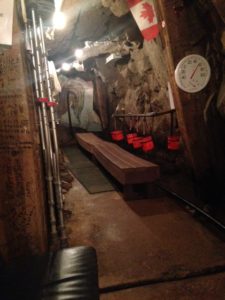
Last week Marika and I camped at Lewis and Clark Caverns, about an hour north of Yellowstone. From there, I had no idea where we were going, just a general direction westward. After the high priced campgrounds, we both were hoping to find some free or less expensive camping for a few days, but every forest campsite I checked would only accommodate RVs up to 20 feet.
I felt stuck and frustrated, and finally, I stopped looking and went to bed.
In the morning, Marika talked with the park ranger about birding in the area and came home with a beautiful brochure of nearby birding spots. And then I remembered that I always imagined we’d plan our route by where the birds are. And sure enough, there was a large refuge listed in the pamphlet in the direction we were going. I had a new town name to research, to find a camp site.
According to RV Park Reviews, the Merry Widow Mine Campground got 9 out of 10 stars. Sites were shaded with full hookups, and some backed right up to the Boulder River. And it was only $19.28 a night if you stayed at least 5 nights. They had availability and we booked it.
When I finally looked on the paper map, I saw that we were only driving 45 miles, and it really wasn’t ON the route. In fact, we were backtracking a few miles. But we were committed. I said, “Something magical is gonna happen for us to be going here.”
We took our time leaving camp since we only had an hour’s drive. We hitched up the car and headed west. Instead of driving the interstate, we took the narrow, winding, two-lane state highway, through rolling hills and pastures. A detour put us on a fairly well-graded gravel road for about 5 miles, then back onto the main highway to our destination.
We pulled in and stopped in front of the rec hall, looking for where to register, and an Amish man with a long gray beard wearing overalls and a long-sleeved shirt approached us. We assumed he was the camp host, welcoming us, but instead he said, “Do you know you’re missing a tire?”
What?
The front passenger tire was gone and it looked like we’d been driving on the rim for a while. The liner inside the wheel base was also gone, and the cables to the headlights were cut. We hadn’t felt a thing.
We unhitched the car and pulled the RV into our space. I called the Toyota dealer in Helena, 26 miles north of camp, and AAA came and towed the car there for a Monday appointment.
Marika called the camp hosts to find out about registering, and when Veronica, the Korean owner, heard we didn’t have a car, she drove down to pick Marika up to take her to the office, which was at the top a fairly steep hill, where the healing mine is.
Years ago, they mined for gold, silver and uranium in this area that lies halfway between Butte and Helena. Several years after the mine closed, a couple re-opened it for healing, based on the belief that radon, in small, controlled doses, eliminates inflammation, the cause of so many diseases.
Healing mines have been popular in Europe for decades. And hundreds of people from Canada come here every year since it is covered under their medical system.
Some folks have voiced concern about the dangers of radon. But that’s why they limit your time in the mine. Like alcohol, a small amount is fine, but too much can cause health problems.
In the campground reviews, folks had mentioned the mine, but I really didn’t know much about it. Now, without a car to explore the area, it seemed like the natural thing to do.
And so, on Saturday morning, we had our first treatment.
There are three ways to take in the healing properties of the mine: breathing the air, soaking your feet and hands, and drinking the water. Some people use an eye cup to rinse their eyes. Some people even bring their arthritic dogs to the doggie den for treatment.
And every single person in the mine has a story: how many years they’ve been coming, how their aches disappeared, how their arthritic fingers unfurled, how their breathing improved.
And they return every year to repeat the 3 times a day, 11 day treatment regime.
We go at 9, 1 and 5 for an hour each time, with three hours in between to release the gases from our system. Veronica has been picking us up since we don’t have a car and it’s a steep walk uphill. Also in the car is a middle aged law professor from Korea who has bone cancer, and her 25 year old son. They are staying in one of the furnished apartments about a mile down the road, and Veronica gives them a ride. They speak very little English, so Veronica translates for us. The woman is impressed that we drive such a big RV. The son is studying economics at University.
At the entrance to the mine, the son helps his mother out of the car and into a wheelchair, and pushes her down the long passageway. We follow, walking about two football field lengths into the mine, through the well-lit, damp, cold corridor. It’s smells a little rusty and my lungs love the dampness. Small stones with handwritten names line the walkway, along with names and dates written in permanent ink on the walls.
We pass a small room designated for bringing your dog, and a curtained alcove with a white bathtub for people who want to do a full soak. The end of the corridor is lined with thin-cushioned benches and seats from an old school bus. There is also a picnic table in an alcove for playing games, doing a puzzle. There are heat lamps hanging from the ceiling, but it’s pretty cold inside-58°.
This is the main treatment room. At the end of the room is a long bench for people to sit and soak their feet in a trough of the magic mine water. There are buckets for you to pour the water on your knees and a plastic tub for soaking your hands and forearms. There is also a spigot so you can drink the water.
Marika and I sit next to each other on the bench nearest the heat lamp and watch the son help his mother onto the seat. She pushes her sleeve up and places her right hand in the long tub of cold mine water, then closes her eyes. After five minutes she dries her hand and her son helps her walk to the bench for the foot soak. The sign above says The Agony of Defeet, and when Marika and I put our feet into the water, I understand why.
The water is 50° and my feet burn from the cold. But I keep them under, breathing calm into the rest of my body. I pull my feet out for a moment and can no longer feel the difference between the cold water and the cold air.
The Korean woman is sitting next to me, whispering in her native tongue. And then she begins to sing. Tears rise up in me and I let the unnamed emotions release. I join in her song, humming the melody as more tears fall. I cry because she is singing for her life and I feel like I have been squandering mine.
And I realize that I am here to be healed, to release the griefs and the fears that hold me in this complacency, to let go of the visions I have for what’s next, and open my lungs and my heart to all that is unknown. And to love bigger and fuller, both myself and others.
The woman is now crying too, and I place my right hand on the back of her heart and cry with her. When our 10 minutes are up and we are drying our feet, we both say thank you.
It is no accident that we are here, that our car won’t be ready until at least Monday. We have extended our stay to take advantage of the full 11 day treatment. Maybe the treatments will clear my lungs. Maybe they will help Marika’s knees. Maybe they will even remove the floaters in her eyes.
It may be days or weeks before we feel the full effects, but already I imagine that we will return next year to repeat the experience.
For more information about radon therapy and the mine, visit www.merrywidowmine.com
The Geyser Effect: What Really Happened at Yellowstone
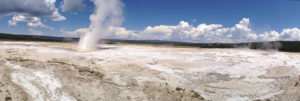
We have never camped over a summer holiday weekend. We’ve always figured, let the working folks enjoy the crowded campgrounds – we have the flexibility to go anytime. But, as full-timers, we needed a place to stay over the long July 4th weekend. As timing had it, we would be near Yellowstone National Park so we committed to being there for the holiday, with the crowds.
All of the state parks were booked and, with the afternoon temperatures in the mid 80’s, we needed a campsite with electricity so we could leave the dogs at home while we ventured out. After all kinds of online searching, a woman in an RVing Facebook group said she owned a campground 20 miles west of Yellowstone’s west entrance. I called and we got a space for the entire weekend, from Thursday through Tuesday. Yes, it was our most expensive campground at $58.32 a night, but, compared to the $80+ at all the other options near Yellowstone, it was the best choice.
The park was nice enough, with full hookups, a few trees and, beyond the campground, expansive views of cattle in pastures and mountains. But our spot was narrow and we were so close to the rigs on all four sides of us, with no view, no cell signal, intermittent wifi, and neighbors who barely looked up when I said hello.
Usually, if I am at a campground like this, I amuse myself with making up stories about the neighbors, or I watch TV, play online or read. But the wifi kept dropping, I had finished my last book over the weekend, and Marika and I were both cranky with each other.
And we were there for five days.
We did spend a full day at Yellowstone, learning how pressure builds up under the Earth’s surface, causing geysers and bubbling mud pots, and the technicolor pools of fiery hot bacterial water. We ate our picnic sandwiches along the Firehole River and I even got my feet in the Madison River with Cody and Mabel. But we saw very little wildlife. Friends had shared how the bison had stopped traffic when they were there, but the only traffic slow-up we experienced was for a single elk standing in a river.
The holiday crowds were daunting. I haven’t experienced so much human energy in one place in years. People moving on all sides of me on the narrow boardwalks and walkways, cars crammed on the side of the road despite the No Parking signs, and the sounds of so many foreign languages and young children’s repetitive questions. By the time we found the car and drove out of the parking lot at Old Faithful, we were both exhausted.
On the drive out of the park we did see a single bison standing in a pool of water. He was huge and still, facing sideways and looking just like the buffalo on a nickel. But there was no safe place to pull over and study him, so we kept driving.
When we got back to camp, we took the dogs for a walk outside of the main camp area along the dirt road that separated the property from the acres of cattle pasture. Swallows swooped over the tall grasses, then ducked into their man-made boxes perched every six feet along the wooden rail fence. But we had to cut the walk short because the mosquitoes were feasting on us, even through the layers of bug spray.
Back in the motorhome, both of us were irritated, snarky, and ready to explode.
Over the weekend, we stayed at camp to avoid the Park crowds. It was windy and thundering, which kept us inside. And all of that closeness and lack of outdoor space did something to me. It was like what happens with the geysers. Pressure builds up under the surface until there is a necessary, somewhat violent release.
I stayed in bed for two days, not talking to Marika, only getting up to pee, walk the dogs and make myself a grilled cheese sandwich. I kept the air conditioner at 75 so I could stay tucked under my favorite blue comforter, moving in and out of tears and sleep, imagining every worst case scenario, focusing on all of my disappointments, irritations and grievances. Which is why I didn’t talk to her. I didn’t want to just spew every thought as it came up. I needed the space to just feel it all without discussion.
And I was so far into it that, of course, I couldn’t explain that to her, not even in a note. And so I was very glad that she kept to her plan to go birding early Sunday morning, because it’s what makes her happy, but then that set me off on another burst of envy because she has a hobby that she loves, and can do for hours, anywhere, any time of day, and I don’t.
Finally, on Monday morning, we talked. About the campground, our relationship, what we both wanted for our future. And she heard me. And I heard her. And we were both able to re-commit to this new adventure.
I have to keep reminding myself that this is all new for us, the planning, the traveling, the co-habitating, the communicating. And that I need to share my feelings, my needs, and lean into the power of this partnership, even when it gets difficult.
That afternoon we made a plan, together, for the next stretch of our journey. We decided to stay longer in the Yellowstone area, and the next morning we moved to the campground at Henry’s Lake State Park just down the road, on the lake, with spacious camp sites, a slough for excellent birding, and trails to walk with the dogs.
We went back to Yellowstone that evening for dusk. We drove along the Grand Loop Road to Hayden Valley, looking for movement in the open fields. We were rewarded with a herd of elk, a gathering of trumpeter swans and even a pair of sandhill cranes.
We got back to our new campsite on the lake after dark and took the dogs for a walk. The new moon glowed a bright sliver in the sky and, even in the darkness, I could feel the water, the pastures, the mountains and the gorgeous space around us. I was so glad to be home.
The Power of Community
![]()
I believe there is great power in working with others. Sharing ourselves with people we trust and respect helps us see many more possibilities and options than we can imagine in our own minds.
If we are really honest with ourselves, we crave intimacy, really talking with a person and connecting at a deeper heart level. We want to be heard and understood and we want to feel supported when we share our wildest dreams and deepest fears.
As humans, we need contact and connection with other people. But what I’m learning is that basic contact isn’t enough. We’re wanting deeper connections with others, and with ourselves.
I’ve been self-employed for 30 years, and, until recently, I also lived alone, so I know, first-hand, how important it is to step outside of my solitary comfort zones and seek the wisdom and companionship of others.
Now that I am living on the road full-time, I no longer have an obvious community. I don’t go to my weekly yoga class or get together with friends for dinner. I don’t see my favorite cashier at Bashas, or chat with my mail carrier at least once a week.
But I talk with other campers and people we meet when we’re out exploring or getting gas. And there are phone calls and FaceTime and emails for keeping in touch with friends and family.
And I have my online communities, people who (for the most part) I have never met in person, but who offer support, amusement and connection. Last year, on my solo Heart Sparks Road Tour, I met quite a few Facebook friends in person, and it was immediately comfortable and real.
And last week, when I was having a hard time finding a place to camp near Yellowstone over the July 4th weekend, I asked for some suggestions on a women’s RVing Facebook group, and a woman replied that she owns an RV park in West Yellowstone and yes, she had availability for the dates that I wanted. So we will be camping this holiday weekend with a new friend, thanks to the amazing world of the internet.
Where do you experience this connection in your own life?
There is a difference between going to a gym and working out in the same room with 20 other people doing their own thing, and joining a yoga class or knitting group where the same people show up each week with a similar purpose. Moving and stretching together creates an energetic connection. The class becomes your community.
Daring to share beyond the surface conversations builds trust and camaraderie. Real friendships begin to form. You are no longer just one person in a vast and lonely world. You are part of something bigger and real, and this is the power of community.
My upcoming virtual Heart Sparks Coaching Circle is a space for all this and more.
We’ll use my book, Heart Sparks: 7 Practices For Loving Your Life as the springboard for our weekly conversations, and create a powerful support net for each other as we explore what’s now and what’s next.
When I think back to the women who have joined me for previous Coaching Circles, several said they joined to meet like-minded women. One of them had little social contact outside of her family. Another worked with with a group of colleagues but realized that it wasn’t real connection. A third had many women friends but their conversations and interactions were somewhat superficial and safe. “I could never talk about this stuff with them,” she shared in one of our gatherings.
I used to think that you couldn’t experience the same kind of intimacy in a group if you weren’t actually sitting in the same room together. But what I’ve discovered is that the connections are actually more powerful and immediate in an online group than when I gather women in person.
So we’ll meet using Google+ Hangouts. It’s free video-chatting software so that we can see each other during our gatherings. We’ll also stay connected through a private Facebook group.
If you’re interested in joining us, send an email. We’ll begin in January.
How To Appreciate a Dirty Spoon
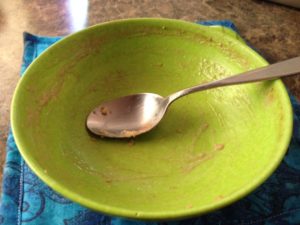
Living in a small space with your dearly beloved is bound to be challenging sometimes. We are two very different people with moods, habits, our preferred ways to do things. For the most part, we work it out. After all, we have 27 years of practicing. But actually we don’t do things the same way we did the first time we lived together.
We’ve had so much time and space living alone since then to develop our own habits and ways to do things, but, for the most part, we compromise without much discussion.
But there is one thing that she does that drives me absolutely crazy. She does not rinse her dishes, and then everything crusts and hardens and I have to work twice as hard to clean them.
I rinse my knives after I slice my sandwich, before I sit down to eat it. For me, cleanup is part of the preparation. For Marika, cleanup happens when there are enough dishes to wash them all at the same time. And then she’ll soak everything first, then wash.
I have no time for pre-soaking, especially since, if they had been cleaned after use, you wouldn’t NEED to.
Different strokes. I get it.
This afternoon, I reached for the knife on the cutting board to slice some strawberries, and was greeted by a congealed smear of mayonnaise. Instead of saying something, I groaned and took a deep breath, wiped off the knife and got a clean one from the drawer. And she said, “What, my mayonnaise knife?” I couldn’t help myself. “So if you know it’s gonna crank me, why don’t you just wipe it off?”
Before she could respond I realized, out loud, “You know, it doesn’t matter. It’s not about the mayonnaise.” I started crying. “I just need to not let it get me so damn cranky.”
So I’m going to try a new response, like “No problem,” or “Gosh, I love her!” And see if I can shift the energy around this.
Because life is not about changing another person. It’s about accepting what is and finding ways to be grateful.
And it’s about the mirror effect. Usually, if something about another person is bugging me, I know that it’s really something about myself that I need look at.
This week, I’ve been especially grumpy all over, not able to feel joy or appreciation, even out in nature among towering rock formations. And I realize I have settled into a bit of complacency with my life again, like I did before my open heart surgery nine years ago.
Yes, look at all I’ve done and changed since then. And yes, this traveling life IS pretty darn good. But I know there is more for me to be doing, sharing, and learning. It’s time for me to stretch a bit past this comfortableness and spend some time at the edges.
Of course, I’ve been using my book, Heart Sparks, to begin the shifts and changes. And when it gets really uncomfortable I am remembering to lean in, not run away. Some days I do better than others. And on the not so great days, I try to be as kind and gentle with myself as possible. Because I know that amazing things are waiting for me on the other side.
I’ll be leading an intimate online Heart Sparks group for women who, like me, are ready for what’s next. Details coming. Email me if you want to be the first to know.
The Balance Between Now and Next
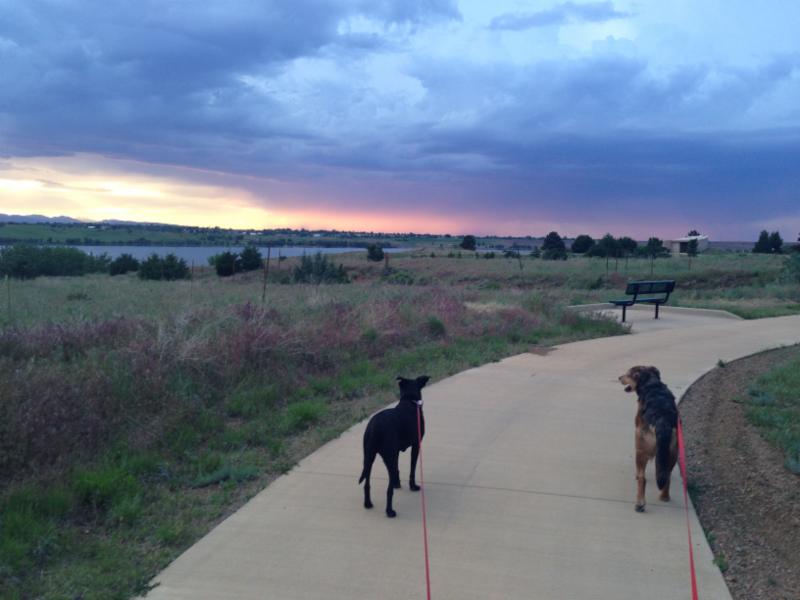
We are at Chatfield State Park in Littleton, Colorado, at a very large, very popular lakeside campground. The campground is full, but the spaces are far enough apart that it doesn’t feel crowded. Our campsite in in the second ring from an uninterrupted view of the lake, but we have a fifty-foot wide open space between campers straight to the water.
And we are so glad to be here for nine days. We are ready for some stillness, some settling in. And yet, despite the bucolic rolling green hills and mountains, and the view of the clear blue lake, I can’t settle into the now, because I don’t know where we’re going from here.
I have only planned our route to this place, to be here to celebrate a friend’s Bat Mitzvah. After here, I know our direction – toward the Grand Tetons and Yellowstone State Parks – but I don’t know our route, or, more important, where we’ll be camping. Summer is high camping season and reservations are a must if I want to have electric hookups so that we can run the a/c.
And so, while I want to just lean in and be here, I feel a need to start looking at and planning the future.
This balancing of now vs next is something we all experience. How to appreciate and be with what is, while still visioning and planning and taking action to move forward. It can be especially challenging if the now is not comfortable or going the way we had hoped.
And it’s not just with big things, like camping reservations. Often, I find myself on a walk with the dogs, but instead of smelling the anise plants and noticing the variations of gray in the sky, I’m planning what time we need to leave in the morning to meet friends.
And that is why it is a balancing. Because I have to connect in both places to keep my momentum.
I can’t just not look ahead to our next destination, or we will not have a place to camp next weekend. And I can’t spend my entire day looking online for possible campsites and routes, because then I’m missing all that is here.
So this morning I sat outside in the early shade and scanned the sky over the lake for white pelicans, and marveled at how close the robins come to our campsite. We watched the black and white magpies scoop between the low juniper trees and delighted that the broad tailed hummingbird found Marika’s feeder. And we began the conversation about where we’d like to be next.
For me, weather is the biggest factor. I expected the mountains here at 5200’ elevation to be cooler, in the 70’s. These 80 and 90 degree afternoons keep us inside, with the windows closed and the shades down. By early evening a storm rolls around us and cools the air and we can walk around the park and play ball in our patch of grasses. But the nights don’t really cool down enough for comfortable sleeping without the a/c on.
Folks have suggested that we explore more of Colorado’s Rocky Mountain areas where it is cooler. But elevations over 6000’ make it hard for me to breathe, and I’m not a big fan of winding mountain roads and scenic overlooks.
So we will head toward the Grand Tetons at a faster pace than originally planned, where it’s still in the 70’s and low 80’s, so that we can be outside during the days to enjoy and explore these new places. I still haven’t picked our campgrounds, but the National Parks have a lot of no reservations spots, so if we get there early enough, we’ll be fine.
Now that I have the beginnings of a plan, I can relax and enjoy the rest of our time here. There is a river to explore, friends to visit with and today, I’m going to pump up my bike tires so I can peddle around the campground for tonight’s silver sunset.
Georgia O’Keeffe’s New Mexico
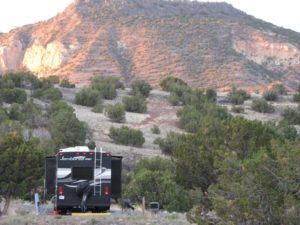
After 5 days in the Albuquerque area, we headed to Georgia O’Keeffe country in northern New Mexico. We stopped first at the Tire Pros and they fixed the two slow leaks. They were so nice and fast and they even pulled the RV in and out, and lined it up for us to hitch up and drive away!
We camped a few miles north of Abiquiu at a Core of Engineers campground perched above the man-made Abiquiu Lake, surrounded by a dramatic, 360° sky and towering red rock hills and canyons.
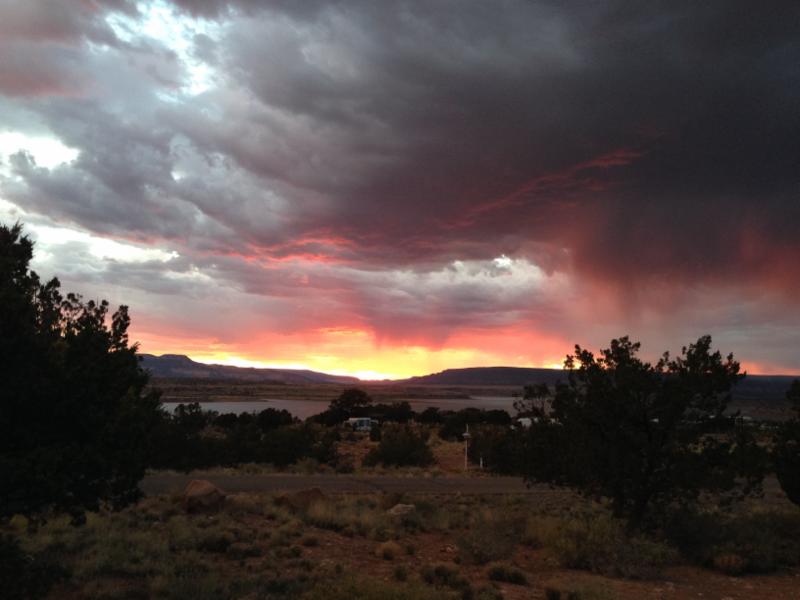
At dusk, after the sun fell behind the stands of red rock, the whole of the sky was ringed in fiery pink clouds, not just in the west where the sun was setting, but all around, like a cloud campfire.
And I wondered what someone from New York City must feel when they experience this for the first time. Does the expansive landscape make them feel vulnerable and lonely, is the silence painful to their ears, are they in awe that this much open space exists outside of their big city world?
This is what I love about the west. The wide open sky, the panoramic views, being able to look out to some distant spot on a faraway cliff and wonder if anyone has ever walked there.
We came here specifically to tour Georgia O’Keeffe’s studio and home, situated above the Chama River and the irrigated patches of farm land below. As Barbara, our tour guide, pointed to the cottonwood trees and then to a photograph of an O’Keeffe painting, I began to see the landscape through O’Keeffe’s eyes: the layers of shapes and textures, colors and shadows, flattened out but somehow, still in perspective.
 We spent the next half-day at Ghost Ranch, an education and research center with a history that includes bandits, Charles Lindburgh, and of course, Georgia O’Keeffe. So many of the visitors come to hike to the stunning mesas. I enjoyed the labyrinth and the walking history tour, and connecting with a friend of a friend who is a volunteer there.
We spent the next half-day at Ghost Ranch, an education and research center with a history that includes bandits, Charles Lindburgh, and of course, Georgia O’Keeffe. So many of the visitors come to hike to the stunning mesas. I enjoyed the labyrinth and the walking history tour, and connecting with a friend of a friend who is a volunteer there.
In the evenings, when the temperature cooled, we took the dogs down to the river side of the Abiquiu Dam for some free running and marveled at the sheer canyon walls. Unlike the Grand Canyon, that was formed by millions of years of river erosion, the canyons here in New Mexico are formed by fast and torrential rains. Entire chunks of the sedimentary rock break off, dry river beds flood and the landscape is forever changed.
 On our last night we drove out to the White Plaza, a place that O’Keeffe painted many times. We drove down a dirt road, past the Al Islam Mosque to a stand of towering white spires, similar to the hoodoos in Utah, but so tall and so white. Cody and I hiked toward them and they were like a magnet, pulling me closer. But the sun was setting and the thunder was rolling in the distance, so we headed back to the car. We got home in time for an amazing sunset of golds and oranges, pinks and reds spread out over the lake, across the distant canyons, filling the entire sky.
On our last night we drove out to the White Plaza, a place that O’Keeffe painted many times. We drove down a dirt road, past the Al Islam Mosque to a stand of towering white spires, similar to the hoodoos in Utah, but so tall and so white. Cody and I hiked toward them and they were like a magnet, pulling me closer. But the sun was setting and the thunder was rolling in the distance, so we headed back to the car. We got home in time for an amazing sunset of golds and oranges, pinks and reds spread out over the lake, across the distant canyons, filling the entire sky.
And then the rains that had been all around us finally found us, and we enjoyed the sounds of our first real rain storm on the RV roof, a steady tapping, like pebbles, accented by flashes of bright lightning streaking the sky over the lake.
On Sunday morning we packed up and headed toward Santa Fe for two nights. After being in Georgia O’Keeffe’s landscape, we couldn’t NOT go to the museum. And we needed to restock the pantries and do laundry. I found a reasonably priced private 55+ park that fit the bill, and the bus stop was right there to take us to the plaza in Santa Fe if we didn’t want to deal with parking!
 On the drive down from Abiquiu, my eyes were drawn to the horizon line and the snow still capping the tops of the mountains more than a hundred miles away. The foreground filled with the expanse of the valley, the line of electric towers that looked like giant Native American symbols, and the lush rows of cottonwood trees along the muddy Chama River. Closer still, fluffs of cotton blew toward the RV’s windshield, and a white butterfly fed on the wildflowers growing along the side of the road.
On the drive down from Abiquiu, my eyes were drawn to the horizon line and the snow still capping the tops of the mountains more than a hundred miles away. The foreground filled with the expanse of the valley, the line of electric towers that looked like giant Native American symbols, and the lush rows of cottonwood trees along the muddy Chama River. Closer still, fluffs of cotton blew toward the RV’s windshield, and a white butterfly fed on the wildflowers growing along the side of the road.
To see far and near, to rest in the middle space. This is what traveling is. This is what life is.
The Georgia O’Keeffe Museum was amazing. We spent the morning in the first three galleries with her early pastels, charcoals and watercolors from east Texas, and her series of watercolor nudes. On the docent-led tour we learned about her early life in Wisconsin, and heard more stories about her wry sense of humor. Then we had to take a break for lunch, to soak it all in.
After a shared BLT, we returned to view O’Keeffe’s New Mexico landscapes. There were only three other people in the large gallery so I could get close to the work and then step back to see them from a distance.
I recognized all of the places we had visited, the trees we had seen, the angles and rounds of the mountains and skies. There were the spires of White Plaza, the flat top of El Pedernal, even the floating pink clouds before last night’s storm. I cried, all full of some kind of heart connection because I saw what she saw and I saw it the WAY she saw it, as shapes and colors in their own dance of perspective.
Marika and I stood in front of the Cottonwood Trees for a long time, remembering how they looked when we stood outside, in front of the clear pane windows of O’Keeffe’s studio, seeing exactly what she had seen – the Chama River, the fertile green valley, and those same cottonwood trees.
We went to the gift shop. We never buy things at the gift shop, but Marika wanted to see if they had a miniature of her favorite piece, the watercolor of people sitting out on the stoop in Texas. And I wanted to get a biography and knew they’d have the most authentic selection.
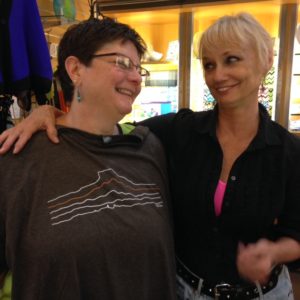
I also looked through the T-shirts and really liked one with five thin horizontal lines, 4 white and one gold, in the shape of El Pedernal. It fit well, and I loved the soft brown fabric, but I decided the book was enough.
I was showing the shirt to Marika when a petite blonde woman in her 40’s said, “Oh, I’m the artist, Christina.” “Well, that must be a sign,” I said. We took a selfie and I bought the shirt, too.
That evening I was flipping through the photographs in the book, and said, “I’d love to come back here, but when it’s much cooler.” “Me too,” Marika said. And so we will, because that, too, is what travel is all about.
It’s Not What Happens, It’s How You Handle It
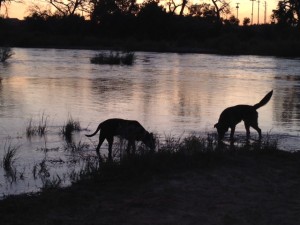
We moved into our new-to-us 2013 motorhome while we were still parked in the driveway at the house, so we had used everything except the shower. During our first week, camped at a full-hookups RV Park in Pinetop, AZ, we discovered that we couldn’t control the water temperature in the shower. We called a mobile repair place and they installed a new shower faucet, and, while they were there, they hung the smoke detector and recommended a great place for burgers.
After the week in Pinetop, we were rested, everything was working and we were ready spend some glorious and quiet time in the high desert of western New Mexico in Datil, pronounced Date-l, at a Bureau of Land Management area 140 miles south and east of Albuquerque. No water or electricity, so we had filled the fresh water tank with 20 gallons and knew that our solar panels could store enough energy for us to run the lights, the water pump, recharge our electronics, and anything else we needed. I had no ATT signal but Marika had a few bars with Verizon so we were able to check in with my Dad to tell him where we were.
It was only $5.00/night, and there was even free wifi at the main check-in booth with a bench out front so you could sit and get online. Our campsite was close enough to the building that we were able to get a signal in the RV if no one else was on.
It was so peaceful to be in the middle of nothing, to hear song birds and the wind in the juniper trees. We walked the nature trail, played stick at the vacant group campground, and Marika even baked cornbread in the RV oven to go with the chili that a neighbor at the previous campground had given us. One morning I sat in my camp chair under a piñon tree and read an entire cottage mystery.
We stayed two nights, then continued along Hwy 60 across the wide open desert toward Albuquerque. After only a few miles into the drive, the transmission pump for the car was beeping. The pump keeps the things lubricated in the engine so we can tow it with all four wheels on the ground. As soon as e reduced our speed it stopped. And then it didn’t beep at all.
We stopped at a repair place just to be sure, to check the car’s transmission fluid and all looked fine, so off we went. No more beeping. Just a smooth and easy drive the rest of the way through the gorgeous open valleys with a panorama of fat clouds and blue sky.
We pulled into a dirt lot in Magdalena and made sandwiches, walked around with the dogs, and switched drivers. I drove the rest of the way to camp just north of Albuquerque along the Rio Grande where we pulled into the WRONG space number because I did not double check the reservation. No big deal, except that one of the leveling jacks was stuck in the almost down position, so we couldn’t move.
At first we thought there was something wrong with the hydraulic jack system, and we freaked out. But then, with a closer look, I could see that the foot of the jack was actually jammed between some rocks in the asphalt slab. And there was no way to move it under the weight of the RV.
Again, we called a mobile repair person and they came the next afternoon, jacked up the RV and dislodged the jack from its stuck position.
It seems that the kick-down jack was just stuck on the asphalt because there wasn’t enough clearance for it to drop all the way down. Because when the jacks were installed, the RV was empty, with no water, no stuff, no people, and now it is heavier and lower to the ground and the jacks need to be adjusted so they have a little more clearance to drop.
That’s all. Easy solution. No big repairs. Just a big service bill, but all is well again. And we made an appointment at a repair place in Albuquerque to check out the system and hopefully, raise the jacks a bit to give us more clearance.
One friend commented, “so maybe this is everything going wrong and things will be perfect again.”
To me, this is perfect. Because this is life. Things are bound to break, get stuck, not work the way you expect. The question is – how do you handle it? Do you get cranky, mad, self-deprecating, impatient with your partner, or can you find a way to distance yourself from the problem so that you can find a solution and move on.
Once we were able to breathe some space between what had happened, we were ready to enjoy the rest of the day. After a quick snack-lunch, we drove into Albuquerque to the REI so that I could get some new hiking shoes. We drove home on the back roads, through undeveloped stretches of high desert, with the Sandia Mountains towering to the east and the sky, so big and wide and blue all around us. We stopped at the Fiesta taco truck for nourishment, had some too-sweet ice cream for dessert, then headed back to camp to walk with the dogs.
The next day we enjoyed a lovely day tripping day: a stop at the Corrales Community Market for tangerine lip balm and blue corn tortillas, still steaming in the bag. Then a drive up into the Sandia Mountains to the Tinkertown Museum that showcases a single man’s wood carvings of miniature towns and scenes and circuses and so much more.
I had attempted to visit Tinkertown last year on my solo trip, but there was absolutely no parking for the RV, so I left. I was thrilled we were doing it on this trip. And together.
Marika loved it as much as me, pointing out the carved vultures perched on the roof and the random birds on the roof tops in the Western scene. We could have stayed much longer, but we were meeting a friend in Madrid (pronounced Má-drid), an abandoned coal mining town along the Turquoise Trail Scenic Highway that has been resurrected by artists. The three of us had a fun time catching up and checking out the local art.
The two-lane highway back to camp stretched across the open high-desert landscape, the wide sky filled with fat white clouds, and the foot-high grasses along the shoulder were blowing in the breeze.
That evening we took the dogs down to the Rio Grande for some free running and stick throwing and, as the sun went down, thousands of bats flew out from under the bridge where we were standing, and filled the air. Canadian geese flew higher in the sky, honking and flapping, and we just stood there, watching, in happy awe.
The Best Thing About Getting Lost

When people ask us what we like most about RVing, we both answer, “being in nature.” And the freedom to explore places outside of the big and busy cities.
Even when we have flown somewhere and stayed in a hotel, we’ve always sought out the quiet, open places, usually where Marika can watch birds.
Today’s article, first published in 2010, is exactly why we love this life!
I grew up reading maps. I have an excellent sense of direction and can usually find where I’m going, even without specific directions. But Southern New Jersey is a web of winding roads where the names on streets don’t correspond to their State Route numbers and, on a cloudy, overcast day, there is no sun to point the way.
Marika and I had driven the rental car to one of the Nature Center’s in Cape May and asked the volunteer for some suggestions where to find shore birds. The man circled several places on a birding map, spouting what birds had been seen at each place.
He pointed to a spot on the western coastline of the map. “They’re dredging here and there were a lot of shorebirds there a few days ago. Just go down to the end of this road,” he pointed, “and you’ll see it.”
Our GPS (nicknamed Mimi) does not understand destinations like “end of the road.”
While Mimi was able to direct us to the general vicinity of the dredged channels, she couldn’t get us to the exact location on the map. We randomly turned down streets, heading toward where we thought the water would be, but instead, we kept crisscrossing the small town’s Main Street.
We were officially lost.
We turned into the Post Office and I asked a State Trooper who had pulled in, for directions.
You’re not even on this map,” he said when I showed him my printed birder’s map.
I asked him about the dredged channels. “I don’t know where he was talking about,” he said, “but if you go down this street almost a mile, turn left on Strawberry, and then just head to the end of the road, there’s a parking lot and a walkway out over the marshes and there are lots of birds out there.”
We followed his directions and pulled into a parking lot in front of an expansive view of salt marshes. The loud chatter of red winged blackbirds filled the air. An osprey flew overhead and Marika quickly got out of the car with her binoculars.
“There’s a nest!” she pointed to the stand of tall dead trees that lined the edge of the salt marsh. Atop one of them was a huge mound of layered sticks and twigs. We watched the osprey land on the nest with a piece of tree brush in it’s talons.
Marika set up her spotting scope and tripod and focused on the nest. “There’s two of them!” I looked through the lens and saw their white and brown heads, the striping on their eyes.
While I studied the pair, she scanned the trees with her binoculars. “Oh my God, it’s a bald eagle.” She focused the scope on it, showing me the bright yellow of his beak and the crisp white of his head. “This is incredible,” she said, “to be able to see them so close.”
I walked the length of the boardwalk while Marika kept her scope focused on the ospreys and the eagle. I stood in the breeze at the end of the walkway, breathing in the fishy, brackish smells. Looking out over the water, I could see unnamed ducks in the far ponds and egrets flying overhead.
I left Marika at the boardwalk and followed the nature trail that was paved with thousands of broken white shells. My boots crunched on the path as I followed it around the edge of the pond, past a fallow corn field where blackbirds and pigeons were feeding, alongside a grassy meadow teeming with butterflies. A white swan floated in the marsh ahead of me. I stood there, just watching and listening and breathing it all in.
When I returned, Marika was at the end of the boardwalk, looking in her bird book. “I’ve seen so many different birds!” she said. “Foster’s terns, laughing gulls, great black backed gulls, green winged teal, great egrets, Canadian geese. And the osprey chased the eagle!”
In the past, I would been bored already, staying in this one place, waiting as she watched. I would have needed a book to read, a journal to write in, snacks to keep me occupied.
But this time was different. I was simply and completely happy to be where we were.
We stayed at the end of the boardwalk for hours and, as the afternoon passed, the water receded with the lowing tide, revealing the mudflats. Dozens of shorebirds appeared and we watched them poking their beaks into the gooey mud for food.
A local couple came with binoculars and their dog, Harley, and we talked about birds and traveling and how beauty is often found right in our own backyards.
“And to think we would have never found this place if we had ended up where we were looking for,” I said.
